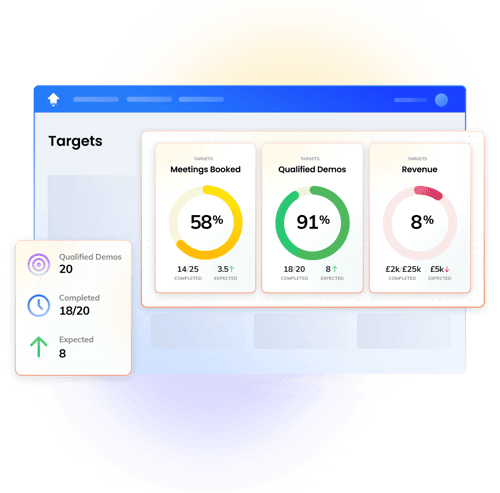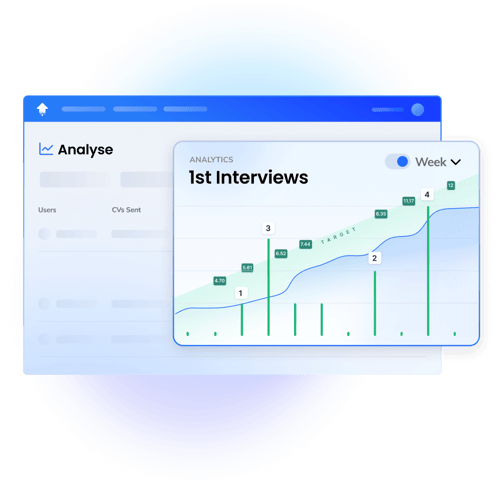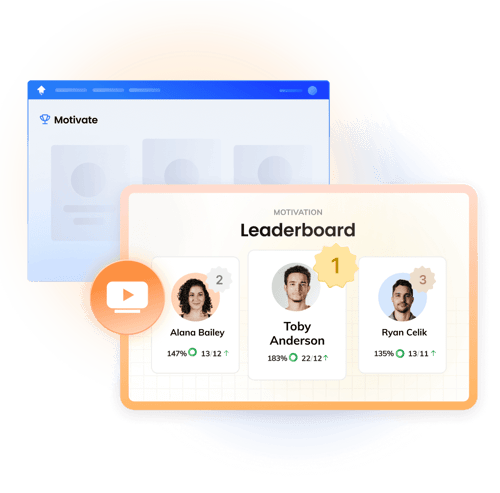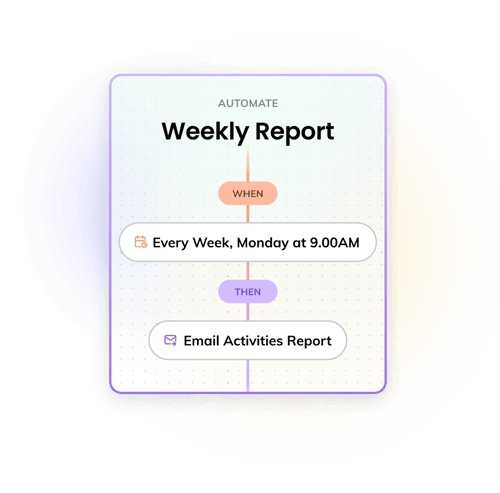Sales performance improvement plans (PIPs) are a useful tool for sales managers who need to boost their sales team's performance or motivate a team member who is failing to meet expectations.
After all, sales managers only have so much resources to hit ambitious revenue targets, and if one or two team members are failing to pull their weight, it’s essential to take action.
While PIPs are often seen as a stressful process for sales reps, when presented correctly, they are a collaborative tool that can help you support team members to upskill and hit their targets.
What’s more, in the dynamic sales landscape of 2024, and with sales analytics tools becoming increasingly advanced, it’s never been easier to pinpoint specific issues within your sales team and target them with a PIP.
In this blog, we’ll provide an in-depth understanding and practical guide to implementing effective Sales PIPs.
PIP Sales Meaning: In-depth Understanding of Sales Performance Improvement Plans
So, what is a PIP in sales?
A sales performance improvement plan — also known as a PIP — is designed to improve the skills, behaviours, and results of sales reps who are failing to achieve.
Within a PIP, the sales manager will highlight specific areas in which the employee in question is required to better their performance — alongside clear, specific goals and targets to hit by certain dates.
The employee must sign the sales PIP document to show they agree to hit the goals and targets laid out within the plan.
Depending on the severity of the issue at hand, the duration of a PIP is typically between 30 and 90 days.
There’s no getting around this — no employee is going to be thrilled when they are handed a performance improvement plan for sales.
Yet while PIPs have a reputation as intimidating, undesirable documents to receive from a manager, the purpose is not to scare sales representatives into improving. Instead, a PIP in sales should be seen as a proactive developmental tool to effectively identify employee weaknesses and help underperforming reps upskill and overcome sales challenges.
When used well, PIPs form a key part of a sales strategy.
To meet your team’s revenue goals, every rep needs to be at peak performance. If a previously high-performing rep is suddenly struggling, or a new hire isn’t pulling their weight, you must take action to avoid your sales strategy veering off course.
The good news is that in 2024, it’s easier — and less time-consuming — than ever before to track niche and relevant metrics.
With tools like OneUp on the market, sales managers can use custom dashboards and in-built motivational tools to set targets for sales reps, track their progress, and get an easy-to-understand visual overview at the touch of a button. You can automate progress reports too, ensuring the managerial task of improving performance does not fall by the wayside.

So what core elements constitute a good sales rep performance improvement plan?
- Clear information on acceptable performance levels
- SMART objectives that are realistic and relevant
- Direction on how exactly management will assist the employee
- Times and dates of progress meetings, coupled with the milestones the sales rep is expected to have hit by each meeting
- Consequences if the sales rep fails to meet the objectives of the plan
Identifying the Need for a Sales PIP
So how can you tell when a PIP sales plan is necessary?
Performance issues can and should be identified using both qualitative and quantitative data.
You may initially spot the sales rep’s underperformance when conducting a data-based one-to-one or carrying out performance analysis. Metrics such as conversion rates, quota attainment, productivity levels, and pipeline quality can all indicate whether an employee is struggling to live up to your expectations.

Alternatively, you may pick up on an issue qualitatively, through feedback from a colleague, a client — or even the sales rep themselves.
Once you have observed that a rep could benefit from a PIP for sales, take the time to observe their skills, from prospecting and qualifying to running meetings, negotiating, and closing.
Once you’ve gathered this qualitative and quantitative data surrounding the sales rep’s performance, you can decide whether a PIP is the best course of action. If it is, analyse the data you have collected to identify skills gaps and areas of improvement for the rep, in addition to potential hurdles to high performance.
Improving sales team performance requires proactivity from managers, however — and in 2024 that’s easier said than done.
Indeed, many sales managers currently lack control of their team’s performance and overall direction.
Why?
How many exceptional sales reps have you seen promoted to team manager, only to flounder at the top due to a lack of training and insights?
Exactly.
This lack of knowledge means often sales managers often spend 90% of their time running business-as-usual tasks or putting out fires; there’s simply no time to be proactive.
But with user-friendly sales performance management software like OneUp now available, the ball is in the sales manager’s court. In 2024, it’s super easy to harness company data and glean insights that will boost team performance — no in-depth training required.
PIPs are a small but extremely useful piece of this puzzle. Take a look at some sales performance improvement plan samples to discover how other sales leaders are using data to inform them.
Designing a Tailored PIP
For a PIP sales plan to be effective, it must be heavily tailored to the individual it concerns. Before developing your own, it’s worth looking at sales performance improvement plan examples to see how other leaders have approached the task.
Here’s how to put one together.
1. Assess Performance
Start by assessing the performance of the sales rep you are considering putting on a PIP.
Gather performance metrics, alongside feedback from colleagues and the employee themselves. If possible, dig out client feedback about the sales rep too.
Analysing this data should paint a picture of whether there truly is a problem, how bad the issue is, and where skills and knowledge gaps lie.
2. Be Specific
Handing a team member a PIP can be an incredibly uncomfortable moment — but there’s no point dancing around the facts. In fact, instead of sparing the recipient’s feelings, it may well simply confuse them.
You need to lay out exactly why the employee has been put on a PIP and outline what success looks like to you as a manager.
Now, how do they get from where they are to tick all your boxes?
3. SMART Goals
To implement an effective PIP format for sales, it must include clear, measurable SMART objectives.
Ensure the objectives are:
- Specific
- Measurable
- Achievable
- Relevant
- Time-bound
Here’s an example. You notice that one of your sales reps has a conversion rate of just 0.5%, while everyone else on the team is at 3% or above. Digging down into their productivity data, it appears they’ve been wasting a lot of time contacting leads that will simply never convert. You offer them training around properly qualifying leads and set them a conversion rate target.
Instead of writing: “Convert more clients in the coming months,” write: “Increase your overall conversion rate to 2% by July 31.”
4. Keep it Realistic
If a sales manager is not careful, a PIP can demoralise an already-struggling worker.
Present them with an unattainable plan, and they will almost certainly become disengaged and disenfranchised.
This is why it’s essential to make sure the expectations and SMART goals you lay out are not only clear but realistic. Consider the skills gaps you’ve identified, the level of support the company has committed to providing, their colleagues’ performance, and the market situation when setting targets.
After all, it’s unfair to expect them to go from struggling to your star rep in the space of one month or so.
5. Offer Guidance
When coming up with a PIP for a sales rep, remember it’s part of your role to offer the training and expert guidance that will help them to become a better sales rep.
Consider their specific skills gaps and challenges, and determine what level of support you and the company are willing and able to offer.
This support could include:
- Training sessions
- Coaching and/or mentoring
- Peer support
- Access to educational resources
Within your PIP, include a clearly defined plan of exactly what help the employee will be receiving, and when they can expect it.
6. Follow-up Meetings
Once set in motion, performance improvement plans must be prioritised.
Giving a sales rep a PIP and then failing to track or give feedback on their efforts to improve is a sure way to disengage them with the initiative.
Build the time and date of regular follow-up meetings into the PIP, alongside which milestones the employee is expected to have hit by then.
7. Keep it Relatively Confidential
There may be some instances in which various colleagues are aware of the existence of a PIP on the team. For example, if the PIP has been set for the whole team, peer-to-peer coaching comprises part of the improvement plan.
For the most part, however, PIPs should be kept relatively quiet.
As they’re often seen as a sign that someone is failing in the role, sharing the news with the sales rep’s colleagues could cause the employee to feel humiliated, disengaged, or even betrayed.
8. Adapt and Scale
While PIPs are commonly used for individual employees, they can also be utilised to improve the performance of a whole team.
As such, they are both adaptable and scalable.
When you’re using a PIP to tackle a team-wide issue, set SMART targets for every individual that feed into an overall group goal.
Sales PIP Implementation and Best Practices
Effectively communicating a PIP to sales personnel is one of the most important and difficult parts of the process.
But the importance of getting this right cannot be understated. So if you’re unsure, start with a sales performance improvement plan template.
If the initial PIP meeting goes badly, or the underperforming sales rep feels they are being treated unfairly throughout the process, they could become demoralised, de-motivate both the team and other colleagues, find a job elsewhere, or even take legal action.
From the first mention of the PIP, it’s important to instil the idea that this is a collaborative effort and that the employee is highly valued by you, their team, and the company — hence why you’re investing in improving their performance.
You need to communicate clearly and transparently with the rep throughout the PIP process, ensure they wholly understand the situation and give positive feedback when they hit milestones and goals.
Overseeing a PIP can be a lot of work for a manager, but with the right tech behind you, tracking metrics doesn’t have to be a headache.
In addition to your tracking activities, give your sales rep the tools to monitor their process to help gain buy-in. OneUp, for instance, offers easily understandable custom dashboards that work on real-time data.

Furthermore, ensure you document every aspect of the PIP, including all communications around it, to ensure the rep fully understands and consents to the PIP, and to protect the company and yourself from any ethical or legal issues that could arise.
Pitfalls and How to Avoid Them
There are a large number of common mistakes managers make when it comes to PIP implementation.
1. A Lack of Clarity
Many sales reps will never have heard of a PIP before — and it’s your job to explain exactly what is PIP in sales, how it applies to them, and what it means for them.
If sales reps do not fully grasp the situation, the PIP will be less effective, either because they do not understand the consequences of failing to improve sales performance, or because they take offence and disengage.
2. Unclear Targets For the Sales Rep
Targets that are not clearly defined are pretty pointless.
For a PIP to be effective, the employee needs to know exactly what is expected of them and by when. They also need to understand what steps will be taken if they fail to hit these targets.
Take a look at a sample sales performance improvement plan to get an idea of how best to phrase SMART targets.
3. Failing to Track Metrics
Once you’ve got buy-in from your sales rep and set SMART targets, you’re halfway there.
Don’t undo all your hard work by failing to track the rep’s progress towards their goals. With tools like OneUp delivering automated progress reports to your inbox, there’s no reason to let tracking fall by the wayside, no matter how busy you are.

4. A Lack of Transparency
Don’t forget to share your dashboards and progress updates with the sales rep on the PIP too.
This gamification should go a long way to motivating the rep and getting their buy-in.
5. No End Point
PIPs absolutely must have an endpoint.
There’s nothing more demoralising than being put on a performance improvement plan with no end in sight. What’s more, it’s hard to stress the reality of the consequences of failing to improve when there’s no deadline.
Your sales rep will need something to work towards — a light at the end of the tunnel.
So give it to them.
6. Failure To Balance Sales Reps’ Strengths With Team Objectives
Every rep has their strengths and weaknesses.
When developing a PIP, it’s important to think about how individual strengths can feed into team goals.
If a rep is a talented closer but seems to struggle with prospecting, ensure you continue to praise their ability to get clients to sign on the dotted line, even while targeting them for performance improvement at the top of the sales funnel.
Sales PIPs in the Future - Predictions and Trends
Recently technological advancements such as AI and machine learning have allowed sales managers to be even more targeted and precise when it comes to performance improvement plans. What’s more, we now have a clearer glimpse into the future with predictive analytics, which warns of obstacles up ahead and allows us to take pre-emptive action.
As tech continues to advance, we can expect to see ever-more granular data sets accessible to sales managers, as well as increasingly sophisticated AI insights that allow for laser-sharp troubleshooting.
The sales landscape has shifted hugely over the past few years, with more informed customers demanding personalised experiences, rapid responses, and seamless interactions throughout the sales process.
This is something sales managers must bear in mind when developing PIPs.
Sales reps who fail to thoroughly research leads ahead of meetings, fail to respond rapidly, or create friction in the customer experience will struggle to thrive in the coming years.
Fortunately, activities such as prep time and response time are easily trackable with 2024-ready tools, while the customer experience can be monitored through analytics, surveys, and social listening.
In the context of changing sales dynamics, future best practices for sales PIPs will likely include:
- Using predictive analytics to test whether SMART targets set during PIPs are achievable, given the support on offer
- Constant real-time monitoring of the sales funnel to detect any issues
- Targeting team members based on their use of data to constantly improve performance
- More customer-centric goals that steer sales reps towards personalisation
Summary
When used correctly, PIPs can produce staggering results — motivating employees to upskill and throw their weight behind team goals.
Continuous improvement and adaptation are a huge part of working in sales, so PIPs are sometimes necessary to nudge reps along on their journey.
But this is a delicate area, and sales managers must develop clear, well-thought-out PIPs that are expertly communicated for positive results.
Leading sales performance management software OneUp puts powerful real-time data insights into sales managers’ hands, making it easier than ever to improve sales team results.

